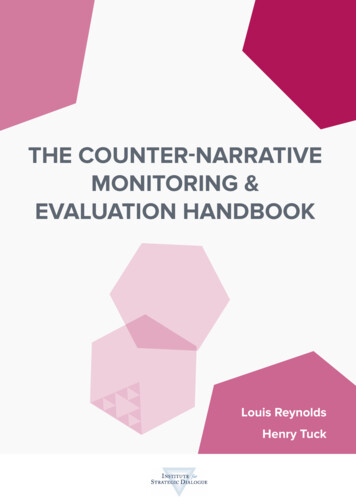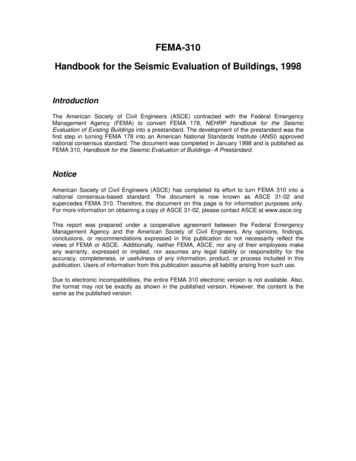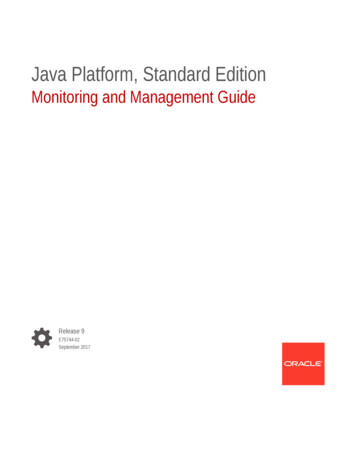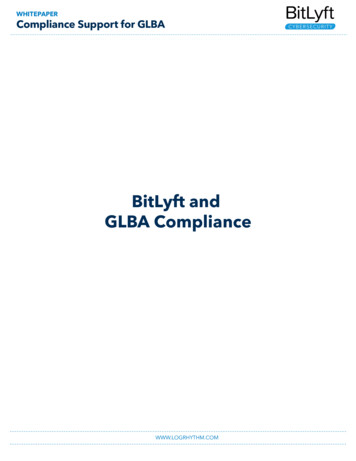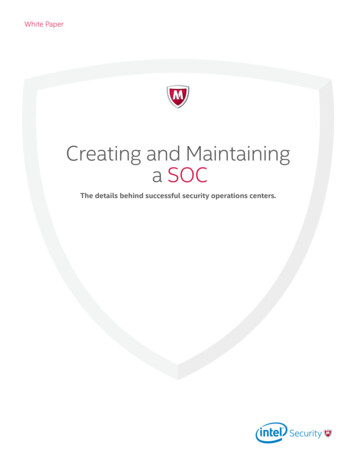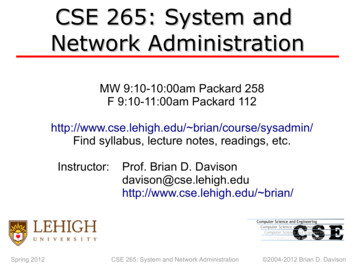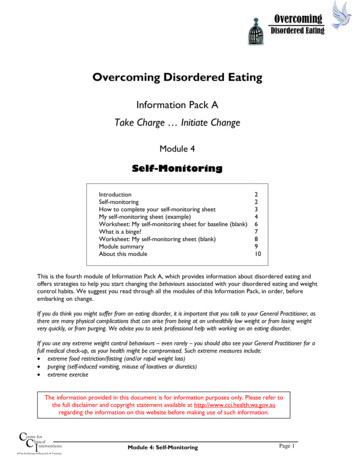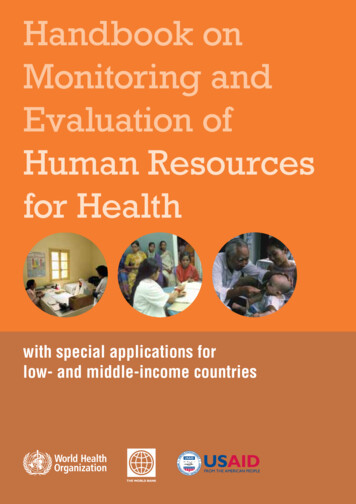
Transcription
Handbook onMonitoring andEvaluation ofHuman Resourcesfor Healthwith special applications forlow- and middle-income countries
Handbook onMonitoring and Evaluation ofHuman Resources for Healthwith special applications forlow- and middle-income countriesEdited by Mario R Dal Poz, Neeru Gupta,Estelle Quain and Agnes LB Soucat
WHO Library Cataloguing-in-Publication DataHandbook on monitoring and evaluation of human resources for health: with special applications for low- andmiddle-income countries / edited by Mario R Dal Poz [et al].1.Health manpower. 2.Health personnel – administration and organization. 3.Health personnel – statistics andnumerical data. 4.Personnel management. 5.Qualitative analysis. 6.Developing countries. I.Dal Poz, Mario RII.Gupta, Neeru. III.Quain, Estelle IV.Soucat, Agnes LB V.World Health Organization. VI.World Bank. VII.UnitedStates. Agency for International Development.ISBN 978 92 4 154770 3(NLM classification: W 76) World Health Organization 2009All rights reserved. Publications of the World Health Organization can be obtained from WHO Press, WorldHealth Organization, 20 Avenue Appia, 1211 Geneva 27, Switzerland (tel.: 41 22 791 3264; fax: 41 22 7914857; e-mail: bookorders@who.int). Requests for permission to reproduce or translate WHO publications –whether for sale or for noncommercial distribution – should be addressed to WHO Press, at the above address(fax: 41 22 791 4806; e-mail: permissions@who.int).The designations employed and the presentation of the material in this publication do not imply the expressionof any opinion whatsoever on the part of the World Health Organization, World Bank or United States Agencyfor International Development concerning the legal status of any country, territory, city or area or of its authorities, or concerning the delimitation of its frontiers or boundaries. Dotted lines on maps represent approximateborder lines for which there may not yet be full agreement.The mention of specific companies or of certain manufacturers’ products does not imply that they are endorsedor recommended by the World Health Organization, World Bank or United States Agency for InternationalDevelopment in preference to others of a similar nature that are not mentioned. Errors and omissions excepted,the names of proprietary products are distinguished by initial capital letters.All reasonable precautions have been taken by the World Health Organization, World Bank and United StatesAgency for International Development to verify the information contained in this publication. However, the published material is being distributed without warranty of any kind, either expressed or implied. The responsibilityfor the interpretation and use of the material lies with the reader. In no event shall the World Health Organization,World Bank or United States Agency for International Development be liable for damages arising from its use.The named authors of each chapter alone are responsible for the views expressed in this publication.Photos: Front cover, left; back cover; pages 23 and 157: Curt Carnemark, World Bank. Front cover, center;and page 1: Ray Witlin, World Bank. Front cover, right; and page 61: Tran Thi Hoa, World Bank.Printed in IndiaEditing, design and indexing by Inís Communication: www.inis.ie
ContentsContentsList of tables, figures and boxes . . . . . . . . . . . . . . . . . . . . . . . . . . . . . . . . . . . . . . . . .viPreface . . . . . . . . . . . . . . . . . . . . . . . . . . . . . . . . . . . . . . . . . . . . . . . . . . . . . . . xAcknowledgements . . . . . . . . . . . . . . . . . . . . . . . . . . . . . . . . . . . . . . . . . . . . . . . .xiList of contributors . . . . . . . . . . . . . . . . . . . . . . . . . . . . . . . . . . . . . . . . . . . . . . . . xiiAcronyms and abbreviations . . . . . . . . . . . . . . . . . . . . . . . . . . . . . . . . . . . . . . . . . . xiiiPart I: OVERVIEW . . . . . . . . . . . . . . . . . . . . . . . . . . . . . . . . . . . . . . . . . . . . . . . . 11 Monitoring and evaluation of human resources for health: challenges and opportunities . . . . . . . 31.1 Introduction . . . . . . . . . . . . . . . . . . . . . . . . . . . . . . . . . . . . . . . . . . . . . . 31.2 Global initiatives on HRH and information systems . . . . . . . . . . . . . . . . . . . . . . . . . . 31.3 Key issues and challenges . . . . . . . . . . . . . . . . . . . . . . . . . . . . . . . . . . . . . . 71.4 Framework for health workforce monitoring: the working lifespan approach . . . . . . . . . . . . . 81.5 Road map . . . . . . . . . . . . . . . . . . . . . . . . . . . . . . . . . . . . . . . . . . . . . . . 91.6 Further information and comments . . . . . . . . . . . . . . . . . . . . . . . . . . . . . . . . . 11References. . . . . . . . . . . . . . . . . . . . . . . . . . . . . . . . . . . . . . . . . . . . . . . . 122 Boundaries of the health workforce: definition and classifications of health workers. . . . . . . . . 132.1 Introduction . . . . . . . . . . . . . . . . . . . . . . . . . . . . . . . . . . . . . . . . . . . . . 132.2 Who are health workers? . . . . . . . . . . . . . . . . . . . . . . . . . . . . . . . . . . . . . . 132.3 Health workforce classification . . . . . . . . . . . . . . . . . . . . . . . . . . . . . . . . . . . 142.4 Summary and conclusions . . . . . . . . . . . . . . . . . . . . . . . . . . . . . . . . . . . . . 21References. . . . . . . . . . . . . . . . . . . . . . . . . . . . . . . . . . . . . . . . . . . . . . . . 22Part II: MONITORING THE STAGES OF THE WORKING LIFESPAN. . . . . . . . . . . . . . . . . 233 Monitoring the active health workforce: indicators, data sources and illustrative analysis . . . . . . 253.1 Introduction . . . . . . . . . . . . . . . . . . . . . . . . . . . . . . . . . . . . . . . . . . . . . 253.2 Core indicators for HRH analysis: what needs to be monitored? . . . . . . . . . . . . . . . . . . 263.3 Overview of potential data sources . . . . . . . . . . . . . . . . . . . . . . . . . . . . . . . . . 273.4 Illustrative analysis . . . . . . . . . . . . . . . . . . . . . . . . . . . . . . . . . . . . . . . . . 313.5 Putting it all together: governance and use of HRH information sources. . . . . . . . . . . . . . 333.6 Summary and conclusions . . . . . . . . . . . . . . . . . . . . . . . . . . . . . . . . . . . . . 34References. . . . . . . . . . . . . . . . . . . . . . . . . . . . . . . . . . . . . . . . . . . . . . . . 36iii
Handbook on monitoring and evaluation of human resources for health4 Framework and measurement issues for monitoring entry into the health workforce . . . . . . . . . 374.1 Introduction . . . . . . . . . . . . . . . . . . . . . . . . . . . . . . . . . . . . . . . . . . . . . 374.2 Framework for monitoring entry . . . . . . . . . . . . . . . . . . . . . . . . . . . . . . . . . . . 384.3 Measurement issues . . . . . . . . . . . . . . . . . . . . . . . . . . . . . . . . . . . . . . . . 424.4 Summary and conclusions . . . . . . . . . . . . . . . . . . . . . . . . . . . . . . . . . . . . . 47References. . . . . . . . . . . . . . . . . . . . . . . . . . . . . . . . . . . . . . . . . . . . . . . . 475 Monitoring health workforce transitions and exits . . . . . . . . . . . . . . . . . . . . . . . . . . . . 495.1 Introduction . . . . . . . . . . . . . . . . . . . . . . . . . . . . . . . . . . . . . . . . . . . . . 495.2 Transitions within and exits from the health workforce: a framework for analysis. . . . . . . . . . 495.3 Indicators and measurement strategies . . . . . . . . . . . . . . . . . . . . . . . . . . . . . . 515.4 Illustrative analyses . . . . . . . . . . . . . . . . . . . . . . . . . . . . . . . . . . . . . . . . . 535.5 Concluding remarks: implications for policy and planning . . . . . . . . . . . . . . . . . . . . . 57References. . . . . . . . . . . . . . . . . . . . . . . . . . . . . . . . . . . . . . . . . . . . . . . . 58Part III: MEASUREMENT STRATEGIES AND CASE STUDIES . . . . . . . . . . . . . . . . . . . . 616 Measuring expenditure on the health workforce: concepts, data sources and methods . . . . . . . 636.1 Introduction . . . . . . . . . . . . . . . . . . . . . . . . . . . . . . . . . . . . . . . . . . . . . 636.2 What should be measured . . . . . . . . . . . . . . . . . . . . . . . . . . . . . . . . . . . . . 646.3 Approaches to measuring HRH expenditure . . . . . . . . . . . . . . . . . . . . . . . . . . . . 656.4 Measurement frameworks and applications . . . . . . . . . . . . . . . . . . . . . . . . . . . . 716.5 Summary, conclusions and further developments . . . . . . . . . . . . . . . . . . . . . . . . . 76References. . . . . . . . . . . . . . . . . . . . . . . . . . . . . . . . . . . . . . . . . . . . . . . . 777 Use of facility-based assessments in health workforce analysis . . . . . . . . . . . . . . . . . . . . 797.1 Introduction . . . . . . . . . . . . . . . . . . . . . . . . . . . . . . . . . . . . . . . . . . . . . 797.2 How facility-based assessments can be used for health workforce monitoring . . . . . . . . . . 807.3 Overview of key HFA methodologies . . . . . . . . . . . . . . . . . . . . . . . . . . . . . . . . 817.4 Some limitations of HFA methodologies for HRH data . . . . . . . . . . . . . . . . . . . . . . . 857.5 Empirical examples based on HFA data . . . . . . . . . . . . . . . . . . . . . . . . . . . . . . 867.6 Summary and conclusions . . . . . . . . . . . . . . . . . . . . . . . . . . . . . . . . . . . . . 98References. . . . . . . . . . . . . . . . . . . . . . . . . . . . . . . . . . . . . . . . . . . . . . . 1008 Use of population census data for gender analysis of the health workforce . . . . . . . . . . . . . 1038.1 Introduction . . . . . . . . . . . . . . . . . . . . . . . . . . . . . . . . . . . . . . . . . . . . 1038.2 Importance of gender considerations in health workforce analysis . . . . . . . . . . . . . . . 1038.3 Using census data for health workforce analysis . . . . . . . . . . . . . . . . . . . . . . . . . 1048.4 Empirical analysis . . . . . . . . . . . . . . . . . . . . . . . . . . . . . . . . . . . . . . . . . 1068.5 Summary and conclusions . . . . . . . . . . . . . . . . . . . . . . . . . . . . . . . . . . . . .110References. . . . . . . . . . . . . . . . . . . . . . . . . . . . . . . . . . . . . . . . . . . . . . . . 111iv
Contents9 Use of administrative data sources for health workforce analysis: multicountry experience inimplementation of human resources information systems. . . . . . . . . . . . . . . . . . . . . . . .1139.1 Introduction . . . . . . . . . . . . . . . . . . . . . . . . . . . . . . . . . . . . . . . . . . . . .1139.2 Recommended first steps to develop a human resources information system. . . . . . . . . . .1149.3 Country case studies . . . . . . . . . . . . . . . . . . . . . . . . . . . . . . . . . . . . . . . .1199.4 Summary and conclusions . . . . . . . . . . . . . . . . . . . . . . . . . . . . . . . . . . . . 125References. . . . . . . . . . . . . . . . . . . . . . . . . . . . . . . . . . . . . . . . . . . . . . . 12610 Understanding health workforce issues: a selective guide to the use of qualitative methods . . . 12910.1 Introduction . . . . . . . . . . . . . . . . . . . . . . . . . . . . . . . . . . . . . . . . . . . 12910.2 Qualitative methods: their value and potential. . . . . . . . . . . . . . . . . . . . . . . . . . 13010.3 Issues in the design and implementation of a qualitative study . . . . . . . . . . . . . . . . . 13210.4 Summary and conclusions . . . . . . . . . . . . . . . . . . . . . . . . . . . . . . . . . . . 143References. . . . . . . . . . . . . . . . . . . . . . . . . . . . . . . . . . . . . . . . . . . . . . . 14411 Analysis and synthesis of information on human resources for health from multiple sources:selected case studies. . . . . . . . . . . . . . . . . . . . . . . . . . . . . . . . . . . . . . . . . . . .14711.1 Introduction . . . . . . . . . . . . . . . . . . . . . . . . . . . . . . . . . . . . . . . . . . . .14711.2 Identification of potential information sources and their use to estimate indicators of health labourmarket participation in Mexico. . . . . . . . . . . . . . . . . . . . . . . . . . . . . . . . . . .14711.3 Using multiple sources of information to produce best estimates of India’s health workforce . 15011.4 Triangulation of data from two different sources for monitoring health worker absenteeism andghost workers in Zambia . . . . . . . . . . . . . . . . . . . . . . . . . . . . . . . . . . . . 15211.5 Summary and conclusions . . . . . . . . . . . . . . . . . . . . . . . . . . . . . . . . . . . 154References. . . . . . . . . . . . . . . . . . . . . . . . . . . . . . . . . . . . . . . . . . . . . . . 155Part IV: DATA DISSEMINATION AND USE . . . . . . . . . . . . . . . . . . . . . . . . . . . . . . . 15712 Getting information and evidence into policy-making and practice: strategies and mechanisms. 15912.1 Introduction . . . . . . . . . . . . . . . . . . . . . . . . . . . . . . . . . . . . . . . . . . . 15912.2 Strategies to get evidence into policy and practice . . . . . . . . . . . . . . . . . . . . . . . 16012.3 A mechanism to harness the HRH agenda: health workforce observatories . . . . . . . . . . 16212.4 Opportunities and directions . . . . . . . . . . . . . . . . . . . . . . . . . . . . . . . . . . 169References. . . . . . . . . . . . . . . . . . . . . . . . . . . . . . . . . . . . . . . . . . . . . . . .170Index . . . . . . . . . . . . . . . . . . . . . . . . . . . . . . . . . . . . . . . . . . . . . . . . . . . . . . . .173About the publishing agencies . . . . . . . . . . . . . . . . . . . . . . . . . . . . . . . . . . . . . . . . .176v
Handbook on monitoring and evaluation of human resources for healthList of tables,figures and boxesTABLESTable 2.1 Framework for defining the health workforce. . . . . . . . . . . . . . . . . . . . . . . . . . . . .14Table 2.2 Relevant levels of education and training for health occupations according to the InternationalStandard Classification of Education (ISCED-1997) . . . . . . . . . . . . . . . . . . . . . . . . . . . . . 15Table 2.3 Fields of vocational training related to health according to Fields of training manual . . . . . . . .17Table 2.4 Occupational titles related to health according to the International Standard Classification ofOccupations (ISCO), 1988 and 2008 revisions . . . . . . . . . . . . . . . . . . . . . . . . . . . . . . . . .18Table 2.5 Economic sectors related to health activities on the basis of the International Standard IndustrialClassification of All Economic Activities (ISIC) Revision 4 . . . . . . . . . . . . . . . . . . . . . . . . . . 20Table 3.1 Selected key indicators for monitoring and evaluation of human resources for health . . . . . . 28Table 3.2 Potential data sources for monitoring the health workforce . . . . . . . . . . . . . . . . . . . . 30Table 3.3 Selected indicators and means of verification for monitoring implementation and use of thenational HRH information and monitoring system to support decision-making. . . . . . . . . . . . . . . . 35Table 4.1 Key indicators and means of verification for measuring entry into the health workforce. . . . . . 44Table 5.1 Potential sources of data on health workforce transitions and exits . . . . . . . . . . . . . . . . .51Table 5.2 Annual numbers of overseas-trained nurses obtaining national licensure to practise in theUnited Kingdom, 1998–2007 (main countries of origin outside the European Economic Area) . . . . . . . 54Table 5.3 Estimates of annual losses due to mortality under age 60 among health workers in selectedcountries of the WHO Africa Region, based on life table analysis . . . . . . . . . . . . . . . . . . . . . . 55Table 6.1 Percentage distribution of expenditure by type of health-care agent, Mexico health accounts,1995 . . . . . . . . . . . . . . . . . . . . . . . . . . . . . . . . . . . . . . . . . . . . . . . . . . . . . . 73Table 6.2 Percentage distribution of expenditure by main providers, Peru health accounts, 2000 . . . . . 73Table 6.3 Remuneration components in the “use” table of the income account, System of NationalAccounts . . . . . . . . . . . . . . . . . . . . . . . . . . . . . . . . . . . . . . . . . . . . . . . . . . . .74Table 6.4 National accounts supply and use table, South Africa, 2002 (millions Rand, partial display) . . . 75Table 7.1 Estimated number of new graduates entering the public sector facility-based health workforce,by cadre, Nigeria 2005 . . . . . . . . . . . . . . . . . . . . . . . . . . . . . . . . . . . . . . . . . . . . 87Table 7.2 Number and density of facility-based health workers, by cadre, Zambia 2006 HFC . . . . . . . 88Table 7.3 Mean number of health workers by type of facility, according to cadre, Kenya 2004 . . . . . . . 89Table 7.4 Number of health workers currently in post, number recommended by staffing norm, and numberrequested by facility managers to meet the norm, by cadre, Kenya 2004 . . . . . . . . . . . . . . . . . . 90Table 7.5 Percentage of facilities reporting having at least one seconded health worker, by cadre,according to management authority of the facility, Kenya 2004 . . . . . . . . . . . . . . . . . . . . . . . 91Table 7.6 Skills mix of facility-based health workers, by type of facility, Kenya 2004. . . . . . . . . . . . . 92Table 7.7 Percentage distribution of health workers in post at health facilities by managing authority,according to cadre, Kenya 2004 . . . . . . . . . . . . . . . . . . . . . . . . . . . . . . . . . . . . . . . 93Table 7.8 Percentage distribution of facility-based health workers and of the total population bygeographical region, Kenya 2004 . . . . . . . . . . . . . . . . . . . . . . . . . . . . . . . . . . . . . . 93Table 7.9 Median number of years of service in current position among facility-based health workers, bytype and management authority of facility, Kenya 2004 . . . . . . . . . . . . . . . . . . . . . . . . . . . 95vi
List of tables, figures and boxesTable 7.10 Percentage of facility-based health workers with written job descriptions, perceived promotionopportunities and other non-monetary incentives, by cadre and type of facility, Kenya 2004 . . . . . . . . 96Table 7.11 Percentage distribution of facility-based health workers by number of hours normally workedper week, according to cadre, Kenya 2004. . . . . . . . . . . . . . . . . . . . . . . . . . . . . . . . . . 97Table 7.12 Comparison of the increase in stock of the public sector health workforce from new graduateswith the attrition rate, Nigeria 2005 . . . . . . . . . . . . . . . . . . . . . . . . . . . . . . . . . . . . . . 99Table 8.1 Countries and sources of census data . . . . . . . . . . . . . . . . . . . . . . . . . . . . . . . 105Table 8.2 Percentage distribution of the health workforce by sex, by occupation, according to census datafor 13 countries (around 2000) . . . . . . . . . . . . . . . . . . . . . . . . . . . . . . . . . . . . . . . . 107Table 8.3 Ratio of women to men by level of educational attainment, health workforce and total population,according to census data for selected countries (around 2000) . . . . . . . . . . . . . . . . . . . . . . . 109Table 8.4 Estimates of intercensal health workforce attrition by sex, Thailand, 1990 and 2000 censuses . 110Table 9.1 Selected indicators and benchmarks from the health workforce information and monitoringsystem in Sudan, 2006–2007 . . . . . . . . . . . . . . . . . . . . . . . . . . . . . . . . . . . . . . . . . 122Table 9.2 Selected indicators and corresponding criteria used for evaluating the performance of theHRH information and management system in Brazil . . . . . . . . . . . . . . . . . . . . . . . . . . . . . 123Table 9.3 Selected indicators and results from the evaluation of the institutional impact of the HRHinformation and management system in Brazil . . . . . . . . . . . . . . . . . . . . . . . . . . . . . . . . 124Table 10.1 Contrasting qualitative and quantitative approaches . . . . . . . . . . . . . . . . . . . . . . . 131Table 10.2 Illustrations of qualitative research on health workers . . . . . . . . . . . . . . . . . . . . . . 133Table 10.3 Group discussions or individual interviews? . . . . . . . . . . . . . . . . . . . . . . . . . . . 135Table 11.1 Questions on education and labour activity included in the national population census andintercensal counts, Mexico, 1995–2005 . . . . . . . . . . . . . . . . . . . . . . . . . . . . . . . . . . . 148Table 11.2 Stock and distribution of the physician and nursing workforce by labour force status, basedon census and survey data, Mexico, 2000 . . . . . . . . . . . . . . . . . . . . . . . . . . . . . . . . . . 149Table 12.1 Main stakeholders and their role in support of the national HRH observatory in Sudan . . . . . 166Table 12.2 Influences of selected achievements of the Brazilian Human Resources for Health Observatoryon policy processes. . . . . . . . . . . . . . . . . . . . . . . . . . . . . . . . . . . . . . . . . . . . . . 167FIGURESFigure 1.1 Working lifespan approach to the dynamics of the health workforce . . . . . . . . . . . . . . . . 9Figure 3.1 Stocks and flows of the health workforce . . . . . . . . . . . . . . . . . . . . . . . . . . . . . 25Figure 3.2 Geographical distribution of the stock of health workers (per 100 000 inhabitants), Viet Namand Mexico censuses . . . . . . . . . . . . . . . . . . . . . . . . . . . . . . . . . . . . . . . . . . . . . 31Figure 3.3 Trends in the distribution of workers in health services by main occupational group, Namibialabour force surveys, 1997–2004 . . . . . . . . . . . . . . . . . . . . . . . . . . . . . . . . . . . . . . . 32Figure 3.4 Distribution of health workers’ salaries by source, according to facility ownership, Rwandahealth facility assessment, 2006 . . . . . . . . . . . . . . . . . . . . . . . . . . . . . . . . . . . . . . . 32Figure 3.5 Gender and skills mix of the nursing workforce in Kenya, Nursing Council of Kenya database,1960–2005 . . . . . . . . . . . . . . . . . . . . . . . . . . . . . . . . . . . . . . . . . . . . . . . . . . 33Figure 4.1 Framework for monitoring entry into the health workforce . . . . . . . . . . . . . . . . . . . . 38Figure 5.1 Transitions within and exits from the health workforce: a framework for analysis . . . . . . . . . 50Figure 5.2 Foreign-born nurses and doctors enumerated in 24 OECD countries by main countries of origin(population census data, around 2000) . . . . . . . . . . . . . . . . . . . . . . . . . . . . . . . . . . . 54Figure 5.3 Estimated lifetime emigration rate of physicians born in selected non-OECD countriesand working in OECD countries at the time of the census . . . . . . . . . . . . . . . . . . . . . . . . . . 55Figure 5.4 Retirement rate among physicians by age group according to the National Medical Associationregistry, Canada, 2005 . . . . . . . . . . . . . . . . . . . . . . . . . . . . . . . . . . . . . . . . . . . . 56vii
Handbook on monitoring and evaluation of human resources for healthFigure 5.5 Proportion of survey respondents reporting a health occupation but not working in the healthservices industry at the time of interview, selected countries. . . . . . . . . . . . . . . . . . . . . . . . . 56Figure 6.1 Overview of the estimation process for measuring labour expenditure in the System of NationalAccounts . . . . . . . . . . . . . . . . . . . . . . . . . . . . . . . . . . . . . . . . . . . . . . . . . . . 67Figure 6.2 Information on the labour market in the Netherlands’ national accounts . . . . . . . . . . . . . 68Figure 6.3 Process to estimate hours worked in the Canadian national accounts . . . . . . . . . . . . . . 69Figure 6.4 Calculation square . . . . . . . . . . . . . . . . . . . . . . . . . . . . . . . . . . . . . . . . 69Figure 6.5 Resource flows in a health system: an accounting representation . . . . . . . . . . . . . . . . 72Figure 7.1 Ratio of facility-based health workers aged under 30 to those aged over 45, by cadre,Kenya 2004 SPA . . . . . . . . . . . . . . . . . . . . . . . . . . . . . . . . . . . . . . . . . . . . . . . 87Figure 7.2 Number and percentage distribution of staff currently in post at health facilities, by cadre,Kenya 2004 SPA . . . . . . . . . . . . . . . . . . . . . . . . . . . . . . . . . . . . . . . . . . . . . . . 88Figure 7.3 Ratio of health workers per inpatient bed, by facility size, Kenya 2004 SPA . . . . . . . . . . . 89Figure 7.4 Percentage of health workers requested by facility managers to meet staffing requirementswho are currently in post, by facility type, Kenya 2004 SPA . . . . . . . . . . . . . . . . . . . . . . . . . 91Figure 7.5 Percentage of health workers and of the total population located in urban areas, Zambia2006 HFC . . . . . . . . . . . . . . . . . . . . . . . . . . . . . . . . . . . . . . . . . . . . . . . . . . . 92Figure 7.6 Median number of years of education and training among health workers, by cadre, Kenya2004 SPA . . . . . . . . . . . . . . . . . . . . . . . . . . . . . . . . . . . . . . . . . . . . . . . . . . . 94Figure 7.7 Percentage of health workers who received in-service training in the past 12 months, and whoreceived personal supervision in the last 6 months, by type of facility, Kenya 2004 SPA . . . . . . . . . . 94Figure 7.8 Percentage of assigned health workers present on the day of the assessment, by cadre,Kenya 2005 SAM (selected districts) . . . . . . . . . . . . . . . . . . . . . . . . . . . . . . . . . . . . . 97Figure 7.9 Attrition rates for health workers in public sector facilities, by cadre, Nigeria 2005 . . . . . . . 98Figure 7.10 Percentage distribution of outgoing health workers by reason for leaving the workforce,Nigeria 2005 . . . . . . . . . . . . . . . . . . . . . . . . . . . . . . . . . . . . . . . . . . . . . . . . . 98Figure 8.1 Sex distribution of the physician workforce, according to census data for selected countries(around 2000) . . . . . . . . . . . . . . . . . . . . . . . . . . . . . . . . . . . . . . . . . . . . . . . . . 106Figure 8.2 Sex distribution of the personal care workforce, according to census data for selectedcountries (around 2000). . . . . . . . . . . . . . . . . . . . . . . . . . . . . . . . . . . . . . . . . . . . 106Figure 8.3 Sex distribution of health systems support staff, by occupation, Uganda, 2002 census. . . . . 108Figure 8.4 Relationship between sex ratio in tertiary-level educational attainment and health professionalwork activity, according to census data for selected countries (around 2000) . . . . . . . . . . . . . . . . 108Figure 9.1 Framework for institutionalizing a human resources information system . . . . . . . . . . . . . 115Figure 9.2 Number of students entering nursing training programmes (leading to qualification asregistered or enrolled nurses) in Uganda, 1980–2004 . . . . . . . . . . . . . . . . . . . . . . . . . . . . 120Figure 9.3 Number of student nurses who entered training between 1980 and 2004, passed theprofessional licensing exam, and qualified, registered and became licensed with the Uganda Nursesand Midwives Council. . . . . . . . . . . . . . . . . . . . . . . . . . . . . . . . . . . . . . . . . . . . . 120Figure 9.4 Number and percentage of student nurses who passed the professional licensing exam and registered with the Uganda Nurses and Midwives Council, by school district (entrants between 1980 and 2001) 121Figure 11.1 Density of the health workforce by cadre, according to data source, India 2005 . . . . . . . . 151Figure 11.2 Density of the health workforce (per 10 000 population) based on census versus survey data,by state, India 2005 . . . . . . . . . . . . . . . . . . . . . . . . . . . . . . . . . . . . . . . . . . . . . . 152Figure 11.3 Percentage of facility-based health workers on the duty roster but not accounted for on theday of the assessment, by cadre, Zambia 2006 . . . . . . . . . . . . . . . . . . . . . . . . . . . . . . . 153Figure 11.4 Percentage of health workers recorded on the Ministry of Health payroll but not registered atthe facility level, Zambia 2006 . . . . . . . . . . . . . . . . . . . . . . . . . . . . . . . . . . . . . . . . 153Figure 12.1 Basis for HRH policies . . . . . . . . . . . . . . . . . . . . . . . . . . . . . . . . . . . . . . 161viii
List of tables, figures and boxesBOXESBox 1.1 Defining monitoring and evaluation . . . . . . . . . . . . . . . . . . . . . . . . . . . . . . . . . . 4Box 1.2 Toolkit for monitoring health systems strengthening . . . . . . . . . . . . . . . . . . . . . . . . . 4Box 1.3 Health-related Millennium Development Goals . . . . . . . . . . . . . . . . . . . . . . . . . . . . 5Box 1.4 Assessment and strengthening of HRH information systems . . . . . . . . . . . . . . . . . . . . . 6Box 1.5 Financial resource needs for strengthening HRH information systems . . . . . . . . . . . . . . . . 7Box 1.6 Human resource needs for strengthening HRH information systems . . . . . . . . . . . . . . . . . 7Box 1.7 Technological resource needs for strengthening HRH information systems . . . . . . . . . . . . . 7Box 4.1 Illustrative example of the establishment of health worker education and training goals andtargets: region of the Americas, 2007–2015 . . . . . . . . . . . . . . . . . . . . . . . . . . . . . . . . . 42Box 4.2 Some notes on data collection, processing and use . . . . . . . . . . . . . . . . . . . . . . . . 43Box 4.3 Illustrative example of data on trends in medical education institutional capacity, recruitment andoutput: Rwanda, 2002–2006 . . . . . . . . . . . . . . . . . . . . . . . . . . . . . . . . . . . . . . . . . 43Box 6.1 Proposed minimum set of indicators for monitoring expenditure on human resources for health . 64Box 6.2 Expenditure components under a health accounting approach through classes of theInternational Standard Industrial Classification of All Economic Activities (fourth revision). . . . . . . . . . 66Box 6.3 Labour data estimation criteria in the national accounts of the Russian Federation . .
Handbook on monitoring and evaluation of human resources for health: with special applications for low- and middle-income countries / edited by Mario R Dal Poz [et al]. 1.Health manpower. 2.Health personnel – administrat

